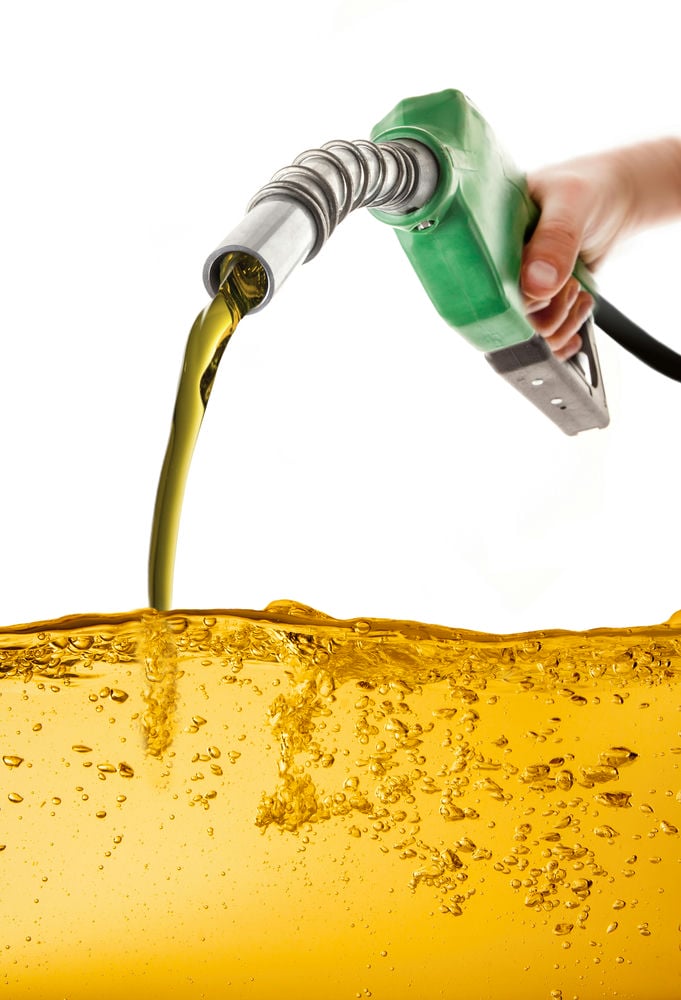Gasoline goes bad through evaporation and oxidation. As it goes bad,
gasoline also goes through color changes.
As gasoline degrades, it loses its clarity and starts becoming dark.
Bad gas can be orange, dark red, or brown. You may even notice some
sedimentation at the bottom.
If the gasoline has been sitting in your car's gas tank or any other
container for a long time, you should check its color before using it. This
is because it has been stagnant long enough to become oxidized if it
appears dark.
But what color is good gasoline? And is it OK to mix the old gas with new
gas? Let's find out.
 Old gas that was siphoned from a gas tank.
Old gas that was siphoned from a gas tank.
What Color Should Gasoline Be?
Pure gasoline is either clear like water or has a slight yellowish
tint. The color can vary according to your location as well as the
grade of gasoline. The clear fuel is colored with dyes, like sulfur, to
distinguish between different octane levels and fuel types.
Here is what color the different grades of gasoline should be:
-
Regular gasoline (87 Octane Rating) has a slight greenish or bluish
tint.
-
Midgrade or Plus gasoline (89 - 90 Octane Rating) has a yellowish
appearance
-
Premium or Super Premium gas (91 - 94 Octane Rating) is usually pink in
color.
Remember, regardless of the color, good gasoline is always translucent. So
if the gas you have appears dark, it is not a good idea to use it.
 Old gas can be yellow in color.
Old gas can be yellow in color.
How Can You Tell If Gas Is Bad?
You can tell if the gas is bad by looking at its color and smelling it.
Bad gas is darker in color than good gas. It also smells weaker.
Color
As gasoline goes bad, it changes its color. The translucent yellowish
liquid starts losing clarity and darkens as the degradation continues.
You may also notice some sediment gathering at the bottom of the gas tank
as the gas goes from orange to red and dark brown.
Smell
Fresh gas has a powerful scent and irritating note that makes breathing
difficult. Bad gas smells weaker.
You may even be able to breathe normally around it. But be careful, as
gasoline vapors are very toxic for the human body.
 Old gas can plug fuel filters.
Old gas can plug fuel filters.
What Does Really Yellow Gas Mean?
Really yellow gas means that the fuel is old.
When gasoline is refined from crude oil at an oil refinery, it becomes a
clear liquid. But before marketing it as commercial-grade fuel, the
manufacturers dye it yellow.
It starts with a light yellow hue but becomes darker as it ages. So, if
your gas is really yellow, it is not fresh.
Is It OK To Mix Old Gas with New Gas?
Ideally, it is better not to mix old gas with new gas. But you can do
so if need be.
Just ensure that the old gas is not too old or contaminated and the
ratio between the old gas and the new one is correct.
Many experts recommend not mixing old gas with new gas. Instead, they
suggest siphoning the old gas from your fuel tank before replacing it with
the new gas.
However, if your old gas is not too old and you believe it is not
contaminated, you can mix it with new gas to safely use it.
Keep a small amount of old gas in the fuel tank and top it up with fresh
gasoline from the gas station.
You can also add a gas treatment to old gas to restore its combustibility.
Topping this mixture up with new gas further dilutes it, making it easy to
burn through your car engine.
 Fouled sparkplugs can be caused by old gas.
Fouled sparkplugs can be caused by old gas.
What Will Bad Gas Do To Your Car?
Bad gas in your fuel tank can lead to rough idles, engine stalling,
acceleration problems, and fuel filter problems.
Here is what may happen when you run your car on bad gas:
Rough Idle & Engine Stalling
Gas goes bad due to evaporation and moisture contamination. This lowers its
combustibility, so the engine may not efficiently burn it, leading to rough
engine idling and stalling.
Acceleration Issues
Accelerating a car requires more fuel than driving it at a constant speed.
If the fuel in your gas tank is bad, it will not burn efficiently,
preventing your car from accelerating smoothly.
Fuel Filter Problems
The sediment in bad gas can plug the fuel filter in your car. This prevents
an adequate amount of gas from reaching the fuel line, causing problems.
Conclusion
Fresh gas is translucent with a light yellow hue. When it goes bad, it
becomes orange, dark red, or brown due to oxidation.
Besides the color change, old gas also smells weaker than its fresh
counterpart.
You can use old gasoline mixed with new gas. Just make sure it is not too
old or contaminated.
Burning bad gas in your engine can cause acceleration issues, engine
stalling, and rough idling.